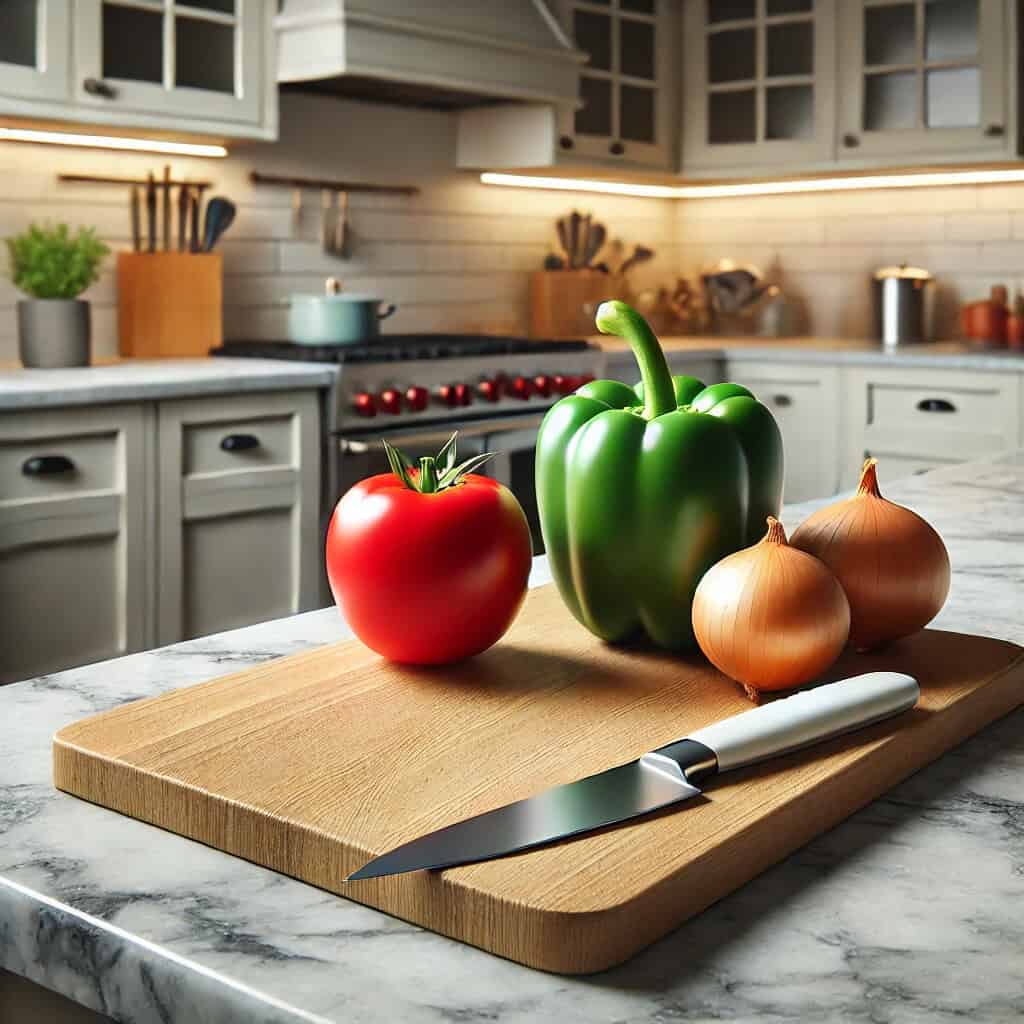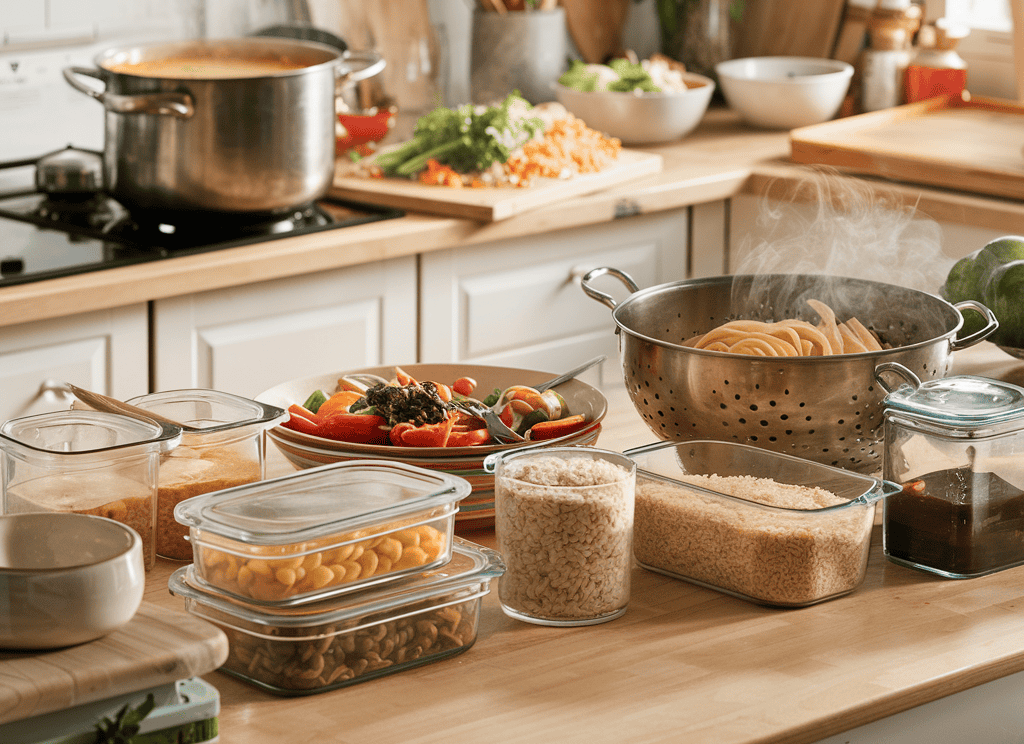Struggling with vegan meal prep? These 70 genius tips will help you save time, keep food fresh, and plan meals effortlessly.
If you’re new to meal prepping, starting can feel overwhelming. But don’t worry—it doesn’t have to be complicated! Check out my guide: 4 Simple Steps to Kickstart Your Plant-Based Meal Prepping Journey for an easy, actionable way to get started today.
So whether you’re a beginner or an experienced meal prepper, these strategies will simplify your routine and keep your plant-based meals delicious all week long!
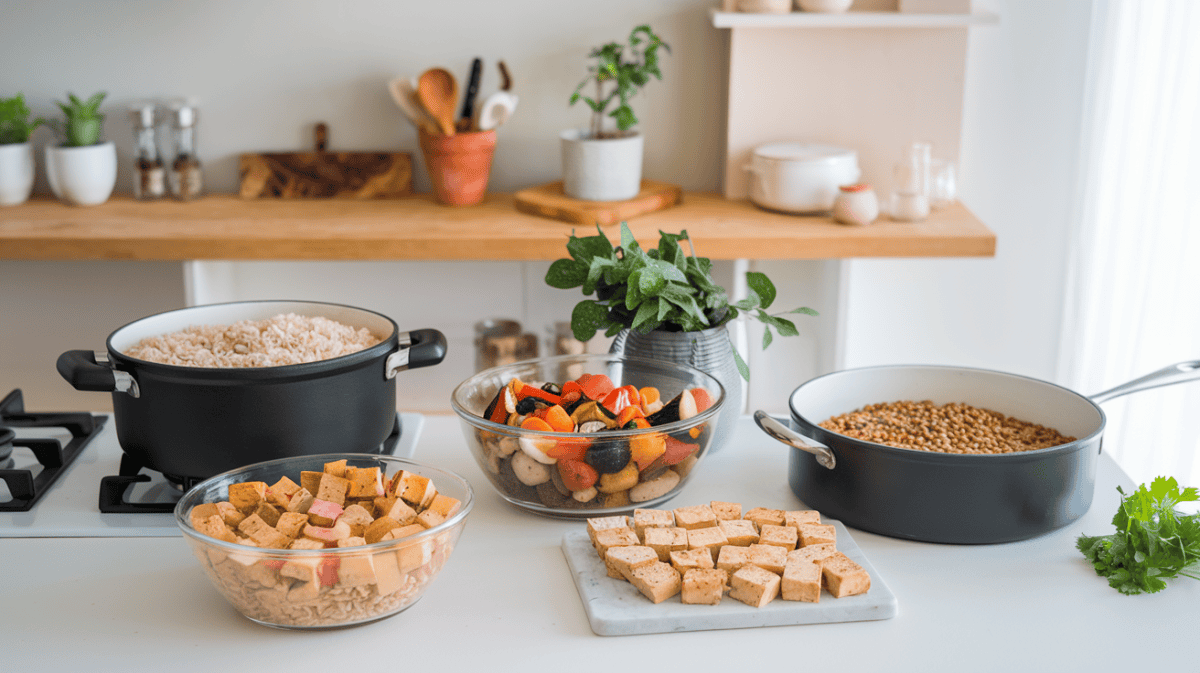
First Things First: Time-Saving Tips for Vegan Meal Prep
1
Batch Cook Grains
Cook large batches of grains at the start of the week. To cook brown rice, quinoa, or couscous, follow the package directions, then store them in airtight containers and mix them into different recipes throughout the week for quick, nutritious bases.
2
Use Frozen Pre-Cut Veggies
Frozen vegetables are already washed and chopped, making them a perfect time-saving alternative. They cook quickly and retain their nutrients, making meal prep much faster.
3
Pre-Chop Vegetables
Chop onions, bell peppers, carrots, and other veggies ahead of time and store them in sealed containers. This saves you time and makes cooking much more efficient.
4
Invest in a Food Processor
A food processor can drastically cut down chopping time. Use it for slicing, shredding, or making sauces in seconds, saving time and effort.
5
Use Canned Beans
Black beans are a great example of canned beans that save hours of soaking and cooking compared to dried beans. Rinse them well before use to reduce sodium content.
6
Buy Pre-Washed Greens
Skip washing and drying salad greens by purchasing pre-washed varieties. They’re ready to use straight from the package, making salads and bowls effortless.
7
Prep Smoothie Bags
Measure out fruits, greens, and seeds into freezer-safe bags. In the morning, just blend with water or juice and a few ice cubes, and your smoothie is ready in seconds.
8
Use a Slow Cooker or Instant Pot
Cook lentils, soups, or stews in a slow cooker or Instant Pot while you handle other tasks. It requires little attention so you can do other things and the results are delicious meals.
9
Roast Multiple Veggies at Once
Save time by roasting various vegetables on a lined baking sheet. Use parchment paper for easy cleanup. Roasted vegetables are a versatile component that can complement various meals throughout the week, such as wraps, bowls, and salads.
10
Make a Big Batch of Vegan Meals
Cook tofu scramble once and portion it out for multiple breakfasts. It keeps well in the fridge for up to five days. For an added boost of flavor and healthy fats, top your tofu scramble with half an avocado.
11
Cook Multiple Meals at Once
While prepping dinner, also cook extra portions for lunch the next day. It minimizes time spent in the kitchen.
12
Use One-Pot Meals
Reduce cleanup by making one-pot meals like stir-fries, stews, and pasta dishes, using spices as a key ingredient to enhance flavor and promote healthy cooking. Less cleanup means more time saved.
13
Prep Snacks in Advance
Make hummus, energy balls, or cut fruit ahead of time to have healthy, grab-and-go snacks available.
Consider adding fresh fruit as a nutritious snack option to complement your meals.
14
Make a Big Pot of Soup
Prepare a large batch of soup and freeze portions in individual containers for quick meals. Look for glass or BPA free meal prep containers to store the soup, as they are versatile for different recipes and practical for freezing food and keeping ingredients separate for reheating.
15
Marinate Tofu or Tempeh in Advance
Marinating adds flavor and makes cooking easier. Store in the fridge overnight for better absorption. Consider using buffalo sauce as a marinade option for an extra kick of flavor!
16
Use Silicone Baking Mats
They make cleanup easy and prevent sticking, eliminating the need for parchment paper or foil.
17
Opt for No-Chop Meals
Recipes like wraps, overnight oats, and smoothie bowls require minimal prep time. Perfect for busy days. Roasted Sweet potatoes are also a versatile ingredient for no-chop ingredient and are so nutritious and delicious.
18
Use a Salad Spinner
Quickly dry greens and herbs to store them properly and extend freshness.
19
Make Freezer-Friendly Meals
Prepare meals that freeze well, such as casseroles, curries, and burritos, to reheat when needed.
20
Pre-Portion Nuts & Seeds
Measure nuts, seeds, and granola into small containers or bags for easy use in meals and snacks.
21
Cook Multiple Plant Proteins at Once
Prepare lentils, chickpeas, and tofu in one cooking session so they’re ready for various meals throughout the week.
22
Use Parchment Paper for Baking
It saves on scrubbing time and keeps your baking sheets clean.
23
Make a Go-To Spice Blend
Having a ready-made spice mix simplifies seasoning meals quickly.
24
Store Homemade Sauces in Jars
Make a batch of your favorite sauce and store it in mason jars for quick use throughout the week.
25
Chop All Onions and Garlic at Once
Save time by chopping or mincing a large batch of onions and garlic. Store in airtight containers or freeze for later use.
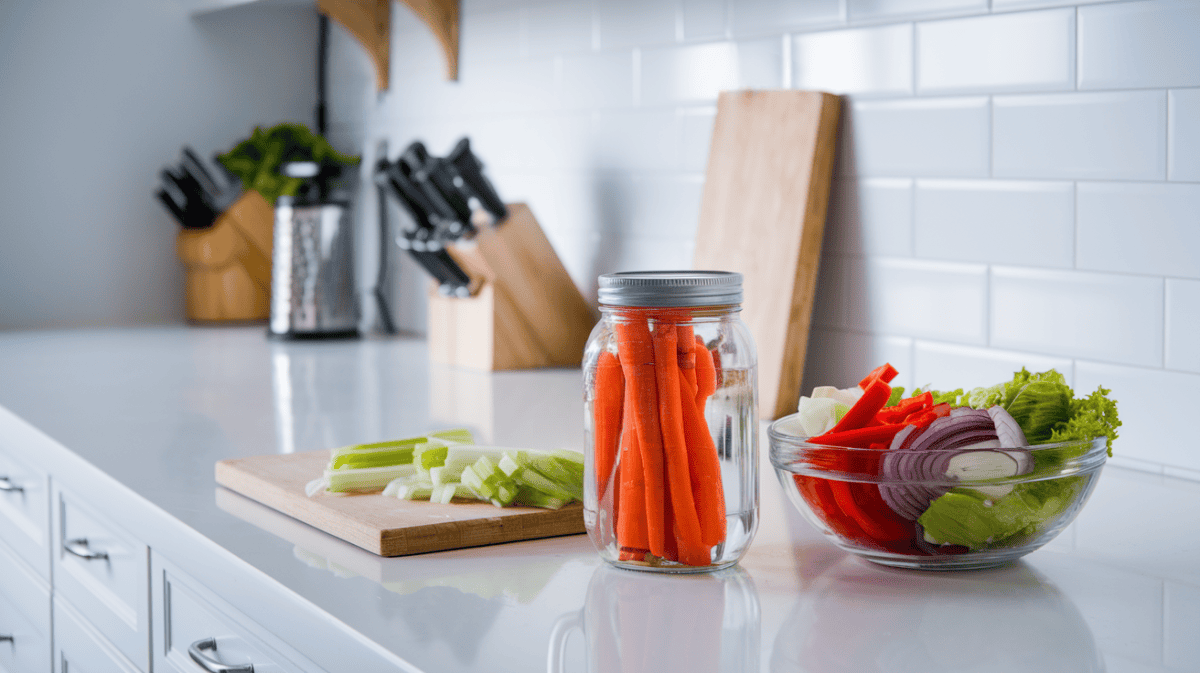
Product Storage & Waste Reduction
26
Store Fresh Herbs in Water
Keep herbs like cilantro and parsley in a mason jar of water in the fridge to extend their life.
27
Use Glass Containers
Glass containers make it easy to see what you have, keeping food fresh and reducing waste.
28
Wrap Greens in Paper Towels
Absorbs excess moisture, preventing leaves from becoming soggy.
29
Freeze Extra Lemon & Lime Juice
Squeeze fresh citrus juice into ice cube trays for later use.
30
Store Cut Avocado with the Pit
It will slow down the oxidation and keeps it fresher longer.
31
Keep Bananas Separate from Other Fruits
Bananas release ethylene gas, which speeds up ripening. Store them separately to prevent premature spoilage of other fruits.
32
Revive Wilted Greens in Cold Water
If your greens look limp, soak them in cold water for 10–15 minutes to refresh them.
33
Label Leftovers with the Name and Date
Use labels to keep track of what and when you prepped your meals to avoid waste.
34
Store Nuts and Seeds in the Freezer
Keeps them fresh longer and prevents rancidity.
35
Use Reusable Silicone Bags
Store chopped veggies, fruit, or leftovers in silicone bags instead of plastic for a more sustainable option.
36
Freeze Leftover Coconut Milk
Pour extra coconut milk into ice cube trays and freeze for later use in smoothies and curries.
37
Store Mushrooms in a Paper Bag
A paper bag absorbs moisture and prevents mushrooms from becoming slimy. A bowl with a paper towel at the bottom and top, loosely covered with plastic wrap works well too.
38
Keep Tomatoes at Room Temperature
Tomatoes ripen best at room temperature. If you aren’t ready to use them once they are ripe, put them in the fridge to preserve them longer.
39
Rehydrate Celery
Put limp celery into a bowl of cool water to rehydrate it and bring it back to life.
40
Freeze Overripe Fruit for Smoothies
If fruit starts to go soft, chop and freeze it for future smoothie use.
41
Store Bread in the Freezer
Prevent mold and waste by keeping bread in the freezer. Toast slices as needed for freshness.
42
Keep Plant-Based Milk Cold
Store plant-based milk on the main fridge shelves, not the door, to keep it at a consistent temperature.
43
Use Airtight Containers for Freshness
Store prepped food in airtight glass or BPA-free plastic containers to extend shelf life and prevent odors from mixing.
44
Keep Potatoes and Onions Separate
Storing them together causes faster spoilage. Keep them in cool, dark places apart from each other.
45
Freeze Fresh Ginger and Garlic
Peel, chop, and freeze ginger and garlic to have them ready for quick meal prep.
46
Store Nut Butters Upside Down
This helps redistribute the oils and prevents dry, hard nut butter at the bottom.
47
Use a Produce Drawer Liner
Placing an absorbent liner in your crisper drawer helps soak up excess moisture, keeping veggies fresher longer.
48
Keep Cut Carrots and Celery in Water
Storing them in water helps maintain crispness for longer periods.
49
Freeze Leftover Tomato Paste
Spoon tomato paste into ice cube trays and freeze for easy portioning. I also like to measure out portions of 1 tablespoon onto a tray and freeze. Once frozen, put the tomato paste clumps into a ziplock freezer back and use as needed for recipes.
50
Keep Berries Dry
Only wash berries right before eating to prevent mold and extend their freshness.
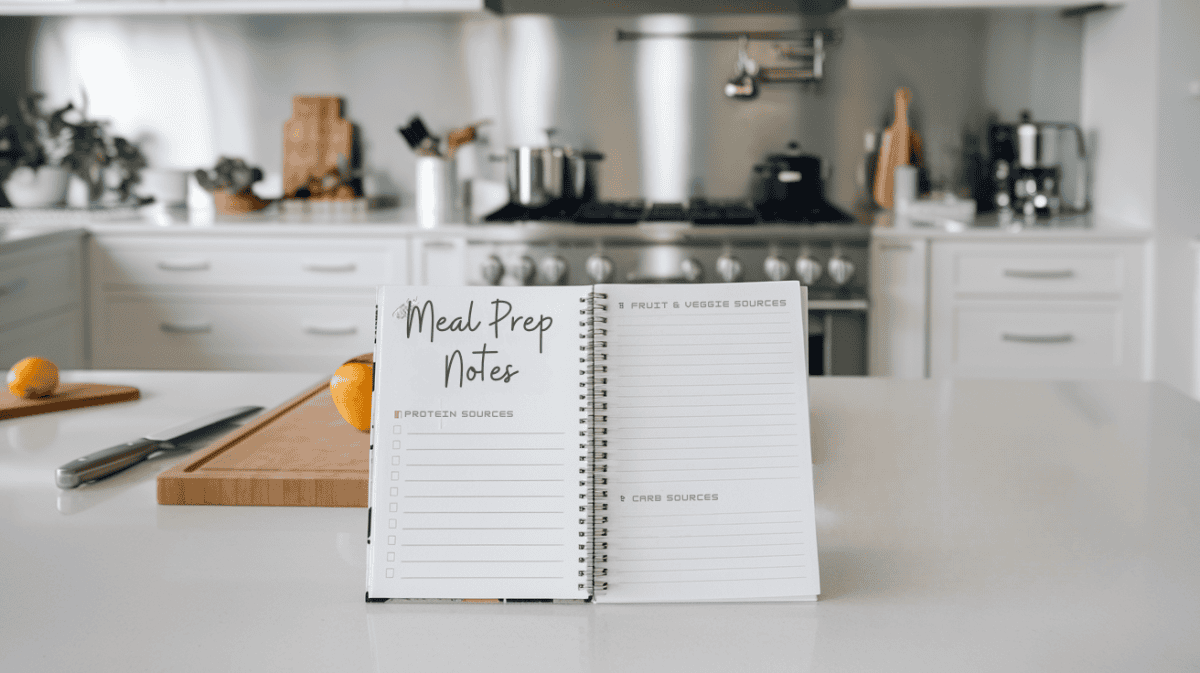
Planning & Organization
51
Plan Your Meals for the Week
A structured meal plan helps reduce food waste and ensures balanced nutrition. Consider planning vegan meals for the week to enjoy a variety of nutritious and versatile plant-based breakfasts, lunches, and dinners.
52
Make a Grocery List
Shopping with a list prevents impulse purchases and ensures you buy only what you need. And don’t go shopping hungry!
53
Schedule Meal Prep Time
Setting aside dedicated time for meal prep ensures consistency and success.
54
Rotate Your Meal Prepping Ingredients
Avoid boredom by switching up staple ingredients every week. For your carb source, make brown rice one week and quinoa the next.
55
Keep a Meal Prep Journal
Track meals you enjoyed and what worked well to refine your system.
56
Use Stackable Containers
Stackable containers maximize fridge space and keep food organized.
57
Store Leftovers in Clear Containers
Being able to see your food helps prevent it from being forgotten and wasted.
58
Use an App for Meal Planning
Apps like MealBoard, Mealime or Paprika can help you organize recipes and generate grocery lists.
59
Have a Backup Meal Option
Keep quick-to-make essentials like frozen veggies, spaghetti with a jar of marinara, and canned beans for when plans change.
60
Pre-Pack Lunches in Portions
Dividing meals into individual portions makes grab-and-go lunches easier. Consider using meal prep bowls for pre-packing lunches, as they offer a versatile and practical solution for meal planning and customization.
61
Keep a “Use First” Bin in Your Fridge
Place items that need to be eaten soon in a designated bin to reduce waste.
62
Organize Your Pantry by Category
Grouping similar items makes it easier to find what you need.
63
Keep a Running Grocery List
Maintain a list of staple items that need replenishing to avoid running out. Put it on the fridge so everyone in the family can add to it.
64
Set Reminders for Perishable Ingredients
Use a note or app to remind yourself of upcoming expiration dates.
65
Label Prepped Meals with Dates
Write the prep date on containers to keep track of freshness.
66
Pre-Cut Veggies for Midweek Cooking
If prepping all meals at once feels overwhelming, chop extra veggies midweek.
67
Organize Your Freezer by Meal Type
Group similar frozen meals together so you can quickly grab what you need.
68
Make Double Batches of Favorite Meals
If you love a meal, make extra portions to freeze it for those busy weeks.
69
Use a Whiteboard for Weekly Meals
Keeping a visible meal plan on the fridge makes sticking to it easier. Consider including a vegan meal in your weekly plan to enjoy nutritious and satisfying options that can be easily prepped in advance.
70
Adjust Meal Prep to Fit Your Lifestyle
Not every tip will work for everyone—experiment and refine your meal prep system to fit your routine and preferences.
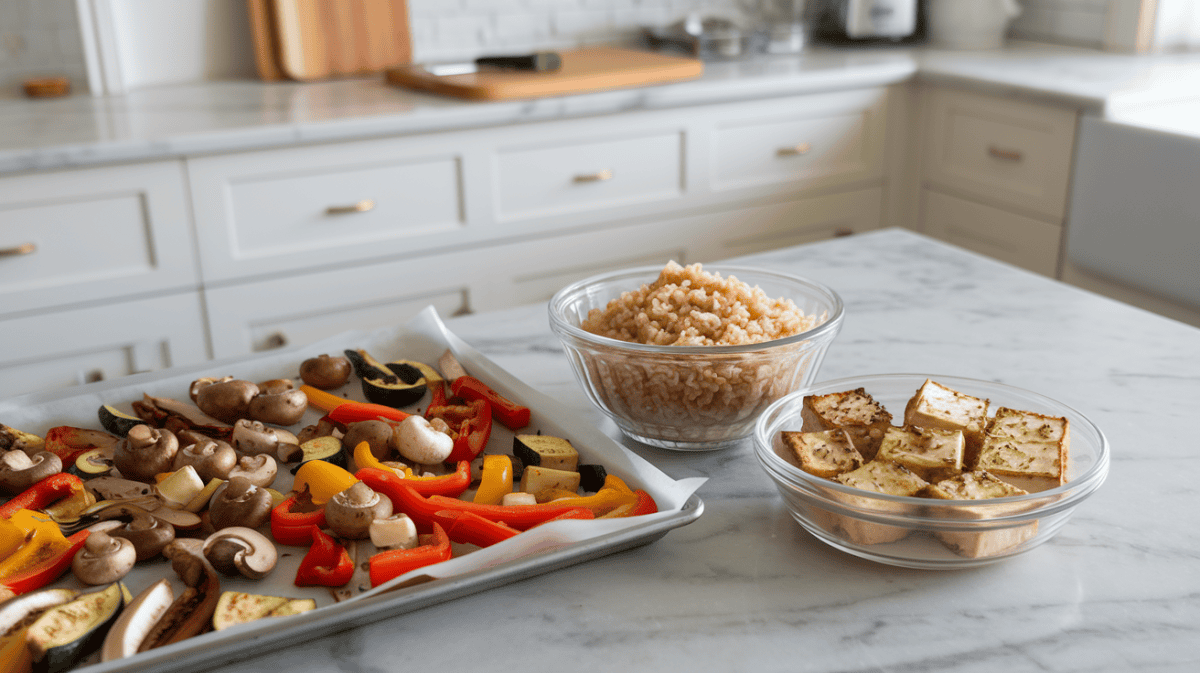
Frequently Asked Questions
How long do prepped vegan meals last in the fridge?
Most prepped vegan meals last 3-5 days in the fridge when stored in airtight containers. For longer storage, freeze meals in portioned containers.
Can I freeze all vegan meal prep foods?
Not all foods freeze well. Cooked grains, beans, soups, and stews freeze great, while fresh salads, high-water veggies (like cucumbers), and creamy sauces may not hold up well.
How do I prevent prepped meals from getting soggy?
Store dressings and sauces separately, keep crunchy ingredients in airtight containers, and avoid overpacking greens in one container.
What’s the best way to keep prepped food fresh longer?
Use glass containers with airtight seals, keep cut produce dry with paper towels, and store food at the right temperature (fridge for short-term, freezer for long-term storage).
How can I save time on meal prep if I’m busy?
Focus on batch cooking, use pre-cut veggies, invest in time-saving tools (like a food processor), and keep meals simple with a few staple ingredients. Having the right tools can make all the difference! Check out my guide on 10 Essential Meal Prep Tools for Success to find the best kitchen gadgets that will save you time.
What are the best vegan proteins for meal prep?
Great options include tofu, tempeh, lentils, chickpeas, black beans, quinoa, and edamame. They store well and provide essential nutrients.
How do I make my meal prep more exciting and not repetitive?
Switch up seasonings, use different sauces, rotate meal types weekly, and experiment with different spice mixes like Mediterranean, Asian, or Mexican.
Can I meal prep for a whole month at once?
It’s possible! Focus on freezer-friendly meals like soups, stews, and grain bowls. Just make sure to label them with names and dates to keep track.
What’s the best way to reheat prepped vegan meals?
For best texture, reheat in a pan or oven instead of the microwave. If using a microwave, add a splash of water to grains to prevent drying.
Do I need special containers for meal prep?
Not necessarily, but airtight glass containers are great for longevity. You can also use silicone bags, mason jars, and stackable meal prep containers.
Make Vegan Meal Prep Work for You
Meal prepping doesn’t have to be overwhelming—start small, stay consistent, and adapt these tips to fit your lifestyle.
But even the best meal preppers make mistakes! Want to avoid common pitfalls that can ruin your hard work? Check out my guide on Common Meal Prep Mistakes and How to Avoid Them to set yourself up for success.
So remember to embrace the process, have fun experimenting with flavors, and celebrate the progress you make. Do you have a favorite vegan meal prep tip that works wonders for you? Drop it in the comments below—I’d love to hear it!
You’ve got this! Happy meal prepping!

